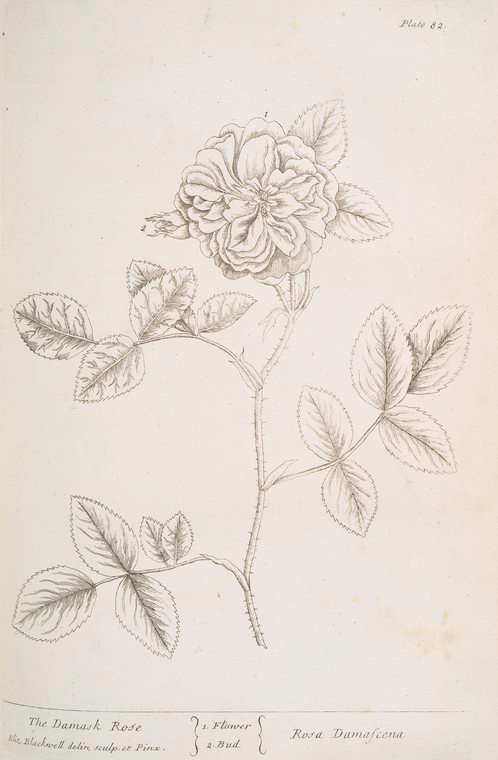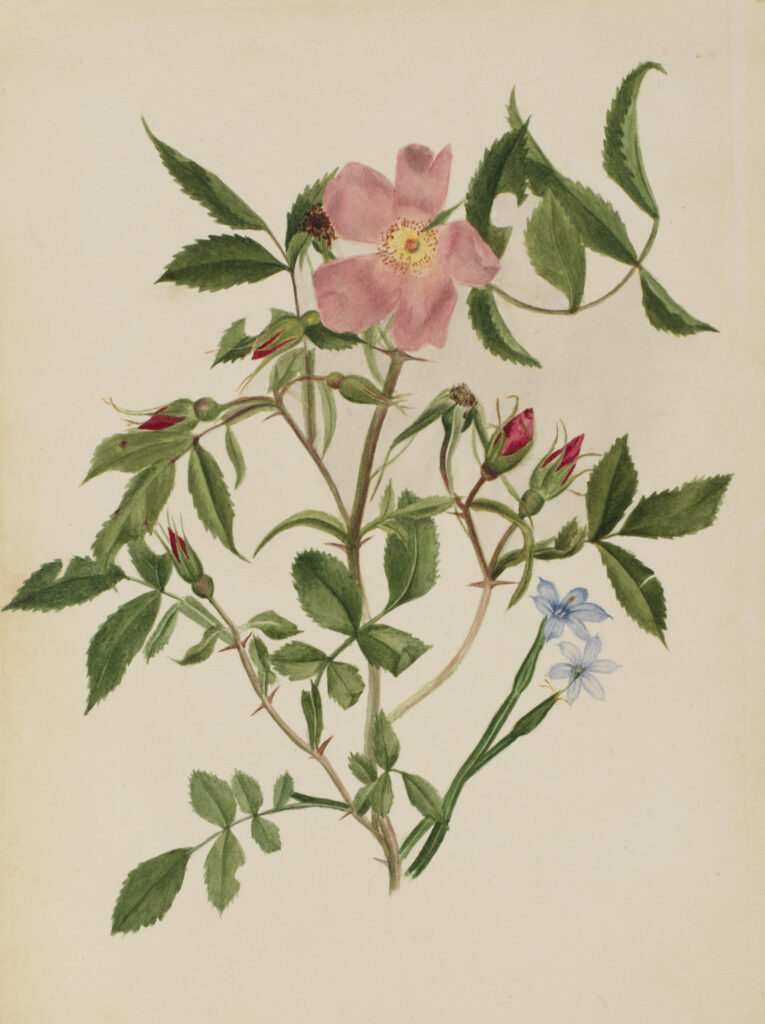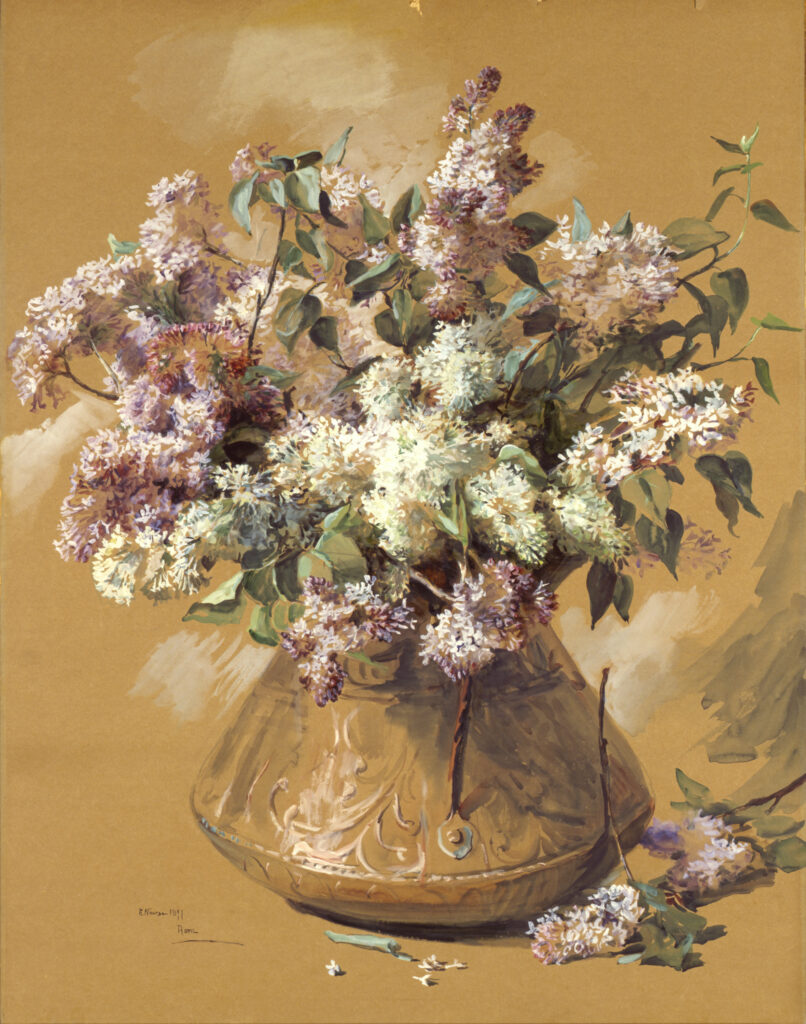The Language of Flowers
A Dialogue for Girls
By A. I. M.
Annotations by josh benjamin
[Child enters, and sits down on a chair. Apron full of
flowers, and straw hat trimmed with them. Six little girls,
each decorated with one of the kinds of flowers mentioned,
come in and form a semicircle behind her.]
CHILD.
Such a long, weary walk have I taken—oh dear!
And the road is so dusty from Maplewood here!
But I wouldn’t have cared for the dust or the sun,
If the flowers would only have whispered me one,
Just one little story of breezes and birds,
Or told me the brooklet’s low murmuring words—
How white blossoms grow from the dark, leafy moold,
And who covers them up when they shiver with cold.
I ran by the brook to the old ruined mill,
The pines held their breath, and the woods were so still!
I’ve heard mamma talk of the language of flowers,
So there I saw watching and waiting for hours;
But not one single word would the naughty things say,
So I picked a great handful and then came away.
I found these wild roses in Sweet-brier Lane,
And, when I got back to the village again,
I stopped to see Nan at the foot of the hill,
To know if her flower-beds would use me so ill.
She gave me these roses, syringas, and pinks,
But not one of the beauties will say what it thinks;
So now I’ll sort over the flowers, while I rest,
And pick out for mamma the kinds she likes best.
Oh! I shouldn’t have minded how far I had walked,
If only the dear, pretty flowers would have talked.
DAMASK ROSE.
The crown of all the summer’s bloom,
The Queen of Flowers am I;
The blossoms that my sunlight share
With me in vain may vie.
But since this child who loves us so
Her tale of grief has told,
From my liege subjects leave to speak
No longer I’ll withhold.


PRAIRIE ROSE.
Clinging and swinging high up in the air,
Many a sight do I see;
Sights that are saddening and sights that are fair,
Sights that are common and sights that are rare,
All are spread out before me.
Golden-hair passes each morning to school,
Happy, and laughing, and bright, as a rule;
Golden-hair sometimes at night is in tears,
Walks as if weary with toil or with years;
What can the reason be?
Butterfly says (a sad gossip is he),
Once he peeped in the window, and happened to see
Golden-hair sitting along in disgrace,
With her hands tied behind and a very red face.
But I don’t believe it was she!
For little girls cannot be idle and play,
When even we roses keep growing all day.
SYRINGA.
An odorous breath from the southland
Floats by in my dreams at night,
And I see my fairer sisters
In their fragrant, creamy white.
Above them hang glowing roses,
That here blossom pale and cold;
And the jessamine clings in a starry mass
To the orange with globes of gold.
But when the chill daylight calls me,
I waken all sick at heart;
And not till I see the world around
Each atom doing its part,
Do I crush back the idle longing
That fills me with sweetest pain,
And bud, and blossom, and fade, and fall,
As a day wears on again.
WILD ROSES.
We wild roses have no story,
Few the words that we can say;
Some kind breeze may waft our fragrance
Out to those who pass our way.
Merry birches laugh above us,
Slender grasses wave below,
Humming-birds glance through our branches,
Busy brown bees come and go.
Day by day our buds, unfolding,
Welcome in the sunlight fair;
Night by night the fading blossoms
Shiver in the dewy air.


New York Public Library Digital Collections.
DANDELION.
Do you love me, little girl?
Love me while you may,
For I wither in your hand
Ere the close of day.
Life to us is short and golden
And our happy souls are holden
With a full and free delight;
So we raise our heads toward heaven,
Drinking in the blessings given,—
Sun by day and dew by night;
Till, upon some breezy morning,
All in misty white adorning
Each bright head,
Stand we, veiled and waiting, ready
To depart, with courage steady.
Angel breezes waft us slowly
Toward the azure, deep and holy,
Overhead.
Earthy longings all are o’er
Evermore.
WHITE WOOD-FLOWERS.
Where the pines ever sigh,
As the breezes go by,
And the waters keep time with their flow,
There we spring from the mold,
There we bud and unfold,
And daily more beautiful grow.
The blacker our leaf-bed, the whiter we rise;
Oh, say! have you never, far up in the skies,
With the sun in a shroud,
And the blast shrieking loud,
Seen snow-crystals fall from the dark, leaden cloud?
Through the long summer day
Merry butterflies play;
But when winter comes they all hasten away.
To what country they go
We blossoms don’t know,
But we are quite safe, folded under the snow.
CHILD.
Oh! you dear, charming beauties, how good you have been,
And what tales you can tell after once you begin!
You startled me so that you made me quite dumb;
Now tell me the rest of your stories at home;
For I have been absent for hours and hours,
And I must tell mamma “the language of flowers.”
“The LAnguage Of Flowers. A Dialogue for Girls.” The christian union 7, No. 21 (May 1873): 414.
Contexts
Floriography, the language of flowers, was a popular subject in the 19th century, during which many books were published as guides to floriography. According to Dr. Carol Howard, by the time the popular Language of Flowers by Kate Greenaway was published in London, there were over 100 such guides available (see link below).
Greenaway’s book contains the following flowers from this dialogue and their representations:
- Damask rose: Brilliant complexion.
- Syringa: Memory or Syringa, Carolina: Disappointment.
- Dandelion: Rustic oracle.
- Aster: Variety. Afterthought. (This is the closest match for the white wood-flower, which is likely Eurybia divaricata, the white wood aster).
Another text on floriography offers a preface on the subject. The excerpt below is from The Language of Flowers. The Floral Offering: A Token of Affection and Esteem; Comprising The Language and Poetry of Flowers by Henrietta Dumont, published in 1851.
“Why has the beneficent Creator scattered over the face of the earth such a profusion of beautiful flowers—flowers by the thousand and million, in every land—from the tiny snowdrop that gladdens the chill spring of the north, to the gorgeous magnolia that flaunts in the sultry region of the tropics? Why is it that every landscape has its appropriate flowers, every nation its national flowers, every rural home its home flowers? Why do flowers enter and shed their perfume over every scene of life, from the cradle to the grave? Why are flowers made to utter all voices of joy and sorrow in all varying scenes, from the chaplet that adorns the bride to the votive wreath that blooms over the tomb?
It is for no other reason than that flowers have in themselves a real and natural significance. They have a positive relation to man, his sentiments, passions, and feelings. They correspond to actual emotions. They have their mission—a mission of love and mercy. They have their language, and from the remotest ages this language has found its interpreters.
In the East the language of flowers has been universally understood and applied ‘time out of mind.’ Its meaning finds a place in their poetry and in all their literature, and it is familiarly known among the people. In Europe it has existed and been recognised for long ages among the people, although scarcely noted by the literati until a comparatively recent period. Shakespeare, however, whom nothing escaped which was known to the people, exhibits his intimate acquaintance with the language of flowers in his masterly delineation of the madness of Ophelia.
Recent writers in all languages recognise the beauty and propriety of this language to such an extent, that an acquaintance with it has now become indispensable as a part of a polished education.
Our little volume is devoted to the explanation of this beautiful language. We have made it as complete as our materials and limits would permit. We present it to our readers in the humble hope that we shall increase the means of elegant and innocent enjoyment by our ‘Floral Offering.’”
Resources for Further Study
- Language of Flowers by Kate Greenaway
- The Language of Flowers. The Floral Offering: A Token of Affection and Esteem; Comprising The Language and Poetry of Flowers by Henrietta Dumont
- The Language of Flowers; or, Floral Emblems of Thoughts, Feelings, and Sentiments by Robert Tyas, M.A., LL.D., F.R.B.S.
- The Literary Gardener by Carol Howard, Ph.D., professor of English and dean of academics, Warren Wilson College
Contemporary Connections
Flowers still have specific meanings, such as red roses for love, lilies for funerals, or poppies, which have come to be associated with remembering fallen soldiers due to the popularity of John McCrae’s World War I poem “In Flanders Fields.”